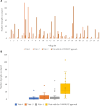Reaching the unreached through building trust: a mixed-method study on COVID-19 vaccination in rural Lao PDR
- PMID: 38843896
- PMCID: PMC11163684
- DOI: 10.1136/bmjgh-2023-014680
Reaching the unreached through building trust: a mixed-method study on COVID-19 vaccination in rural Lao PDR
Abstract
Introduction: The global COVID-19 vaccine rollout has been impacted by socioeconomic disparities and vaccine hesitancy, but few studies examine reasons for changed attitudes. In Lao People's Democratic Republic (Lao PDR), a nationwide government-led initiative was developed in response to COVID-19, focused on community health ownership and trust in primary healthcare. The intervention team including health and governance sectors conducted capacity-building workshops with local staff and community representatives and visited villages for vaccination outreach. This study investigates the impact of this intervention on COVID-19 vaccine acceptance in rural communities.
Methods: Conducted in Xiengkhuang province, Lao PDR, from December 2022 to February 2023, the study employed a sequential mixed-methods research design. Data on vaccinated individuals from 25 villages were collected from 11 primary healthcare units; pre-post analysis was applied. Qualitative data, gathered through interviews and focus group discussions with villagers, village authorities, health staff and local government (n=102) in six villages, underwent inductive thematic analysis.
Results: First-dose vaccine uptake after the intervention increased significantly (6.9 times). Qualitative analysis identified key reasons for vaccination hesitancy: (1) mistrust due to rumours and past experiences; (2) poor communication and inconsistent messaging and (3) challenges in access for priority groups. Influencing factors during the intervention included (1) effective local-context communication; (2) leveraging existing community structures and influential individuals in a multisectoral approach and (3) increased community motivation through improved satisfaction, ownership and relationships.
Conclusion: This study highlights the impact and methods of building trust with unreached populations in health interventions, emphasising locally led solutions. Successful reversal of vaccine hesitancy was achieved by addressing root causes and fostering ownership at community and local government levels through a 'positive approach'. This diverges from conventional supplemental immunisation activities and holds potential for systematically building trust between unreached populations and health systems. Further research could explore the impacts of routine vaccination for sustained improvements in health equity.
Keywords: COVID-19; Prevention strategies; Qualitative study; Vaccines.
© World Health Organization 2024. Licensee BMJ.
Conflict of interest statement
Competing interests: None declared.
Figures




Similar articles
-
Community engagement and local governance for health equity through trust: lessons from developing the CONNECT Initiative in the Lao People's Democratic Republic.BMJ Glob Health. 2024 Sep 28;9(9):e015409. doi: 10.1136/bmjgh-2024-015409. BMJ Glob Health. 2024. PMID: 39343440 Free PMC article.
-
Community engagement to support public health: mixed-method evaluation evidence on COVID-19 attitudes and practices in Lao PDR.Glob Health Action. 2025 Dec;18(1):2485523. doi: 10.1080/16549716.2025.2485523. Epub 2025 Apr 25. Glob Health Action. 2025. PMID: 40277016
-
COVID-19 vaccine hesitancy, trust, and communication in Sarlahi District, Nepal.Vaccine. 2024 Nov 14;42 Suppl 5:126034. doi: 10.1016/j.vaccine.2024.06.002. Epub 2024 Jun 10. Vaccine. 2024. PMID: 38862309
-
Addressing vaccine hesitancy and resistance for COVID-19 vaccines.Int J Nurs Stud. 2022 Jul;131:104241. doi: 10.1016/j.ijnurstu.2022.104241. Epub 2022 Apr 1. Int J Nurs Stud. 2022. PMID: 35489108 Free PMC article. Review.
-
Interventions to increase COVID-19 vaccine uptake: a scoping review.Cochrane Database Syst Rev. 2022 Aug 3;8(8):CD015270. doi: 10.1002/14651858.CD015270. Cochrane Database Syst Rev. 2022. PMID: 35920693 Free PMC article.
Cited by
-
Community engagement for stakeholder and community trust in healthcare: Short-term evaluation findings from a nationwide initiative in Lao PDR.Soc Sci Med. 2024 Aug;354:117079. doi: 10.1016/j.socscimed.2024.117079. Epub 2024 Jun 27. Soc Sci Med. 2024. PMID: 38954978 Free PMC article.
-
Immunisation health workforce capacity building in Southeast Asia: reflections from training programme implementation in Cambodia and Lao PDR.BMJ Glob Health. 2025 Feb 19;10(2):e018007. doi: 10.1136/bmjgh-2024-018007. BMJ Glob Health. 2025. PMID: 39971585 Free PMC article.
-
Community engagement and local governance for health equity through trust: lessons from developing the CONNECT Initiative in the Lao People's Democratic Republic.BMJ Glob Health. 2024 Sep 28;9(9):e015409. doi: 10.1136/bmjgh-2024-015409. BMJ Glob Health. 2024. PMID: 39343440 Free PMC article.
References
-
- World Health Organization . COVAX calls for urgent action to close vaccine equity gap. 2023. Available: https://www.who.int/news/item/20-05-2022-covax-calls-for-urgent-action-t... - PMC - PubMed
MeSH terms
Substances
Grants and funding
LinkOut - more resources
Full Text Sources
Medical
Miscellaneous
